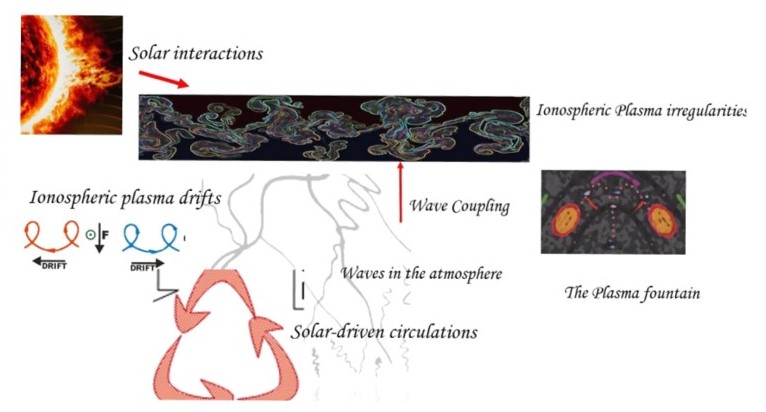
Department of Physics
University of Kerala
Established in 1970
Re acreditted by NAAC with A++ grade
Department of Physics
University of Kerala
Kariavattom Campus
Thiruvananthapuram
Research Theme: Morphology of Earth’s Ionosphere-Thermosphere System
Rationale of my research: Earth’s ionosphere over the magnetic equator is characterized by the
presence of plasma irregularities during certain nights, referred as equatorial spread F (ESF).
These irregular structures can rigorously affect numerous applications including the positioning
and navigation in Global Positioning System, communication and remote sensing etc. The
fundamental features of the processes responsible for the generation of these irregularities are not
completely understood. The complexity lies in the fact that so many parameters are to be
considered simultaneously. It has been reported that even under the identical background
conditions, there is no guarantee on the occurrence of ESF. The night-to-night variability of this
phenomenon provides evidence about the coupling of different atmospheric processes as well as
the complexity involved in predicting it. The current understanding in the field of ionospheric
research is not sufficient to account completely, for the variability of these processes. The major
reason is the lack of detailed understanding regarding the coupling existing among different
factors. This points to the need for systematic studies to bring out the role various parameters
like the wind system, gravity waves and planetary waves, ionospheric conductivity, lower
atmospheric-, thermosphere-, solar- forcing etc as well as their interdependencies in a
quantitative manner as well as to develop prediction schemes for irregularities and scintillations.
Thus while these studies will cater to the scientific curiosity, they will at the same time aid in
forecasting the status of the ionosphere which is extremely important for mitigating
communication and navigation outages A comprehensive analysis on the various of solar,
atmospheric-, thermospheric factors inclusive of plasma drifts, plasma fountain, atmospheric
waves, neutral density are need to be established for the complete understanding.

Details of my research work: The characteristics and climatology of the Gravity Wave induced
Travelling Ionospheric Disturbances (GW-TIDs) in the ionosphere and their quantitative role in
modulating the day-to-day variability of Equatorial Spread F are addressed (ASR, 2016; JASTP,
2017). It is revealed that the amplitude of the GW-TID is a very critical parameter which
decides, whether or not Equatorial Spread F would occur on a given day and that, this threshold
level of seed perturbation amplitude required on a given day decreases as the post sunset height
of the F- layer increases (JGR, 2017). The role of neutral density in modulating the threshold
curve amplitude of the seed perturbations (gravity wave induced perturbations) for Equatorial
Spread F initiation was addressed (JGR, 2018a).The response time of Equatorial Ionization
Anomaly (EIA) crest ionization and its location, its seasonal and solar activity variability, the
causative mechanisms, linkage between the EIA delay and the Equatorial Spread F, for the days
when the F-layer base is in the neutral dynamical domain were explored (JGR, 2018b). Empirical
models were generated for hind-casting the ESF events for the days belonging to the
electrodynamics- domain (JGR, 2018c). The effect of the time of evening zonal drift reversal in
F- region on the post sunset ionosphere is established, for the first time (JASTP, 2020). The
seasonal and solar activity variation of the post sunset F- region zonal plasma drift, at the
magnetic equatorial region is analyzed for magnetically quiet conditions and its linkage with the
plasma irregularities are addressed (ASR, 2020). Role of the planetary planetary waves in the
off-equatorial E- region and the subsequent modulation of F region parameters via the magnetic
field lines were examined (JGR, 2020). Effect of the near sunset EIA crest magnitude on
modulating the post sunset irregularities on a night-to-night basis is extracted (ASR, 2021). I have
worked on the testing and analysis on the Ionization Density and Electric-field Analyzer (IDEA)
payload on board the Polar Satellite 4 (PS4) stage provided electron density and electric field
information at the F region altitudes (JASTP, 2019).
Significance of my research work: While my studies will cater to the scientific curiosity, they
will at the same time aid in forecasting the status of the ionosphere which is extremely important
for mitigating communication and navigation outages.
Publications: 12 Publications in international peer-reviewed journals.